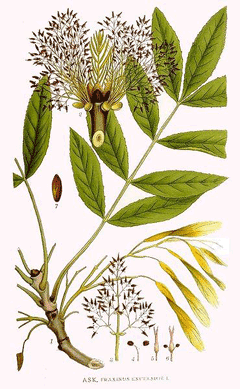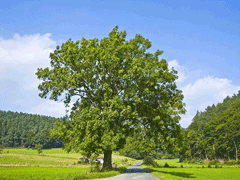 |
|
http://commons.wikimedia.org/wiki/File:74_Fraxinus_excelsior.jpg |
 |
|
Translate this page:
Summary
Bloom Color: Green. Main Bloom Time: Early spring, Late spring, Mid spring. Form: Rounded.
Physical Characteristics

 Fraxinus excelsior is a deciduous Tree growing to 30 m (98ft) by 20 m (65ft) at a fast rate.
Fraxinus excelsior is a deciduous Tree growing to 30 m (98ft) by 20 m (65ft) at a fast rate.
See above for USDA hardiness. It is hardy to UK zone 4 and is not frost tender. It is in leaf from May to October, in flower from April to May, and the seeds ripen from September to January. The species is dioecious (individual flowers are either male or female, but only one sex is to be found on any one plant so both male and female plants must be grown if seed is required). and is pollinated by Wind. The plant is not self-fertile.
It is noted for attracting wildlife.
Suitable for: light (sandy), medium (loamy) and heavy (clay) soils. Suitable pH: mildly acid, neutral and basic (mildly alkaline) soils and can grow in very acid soils.
It cannot grow in the shade. It prefers moist or wet soil. The plant can tolerate maritime exposure.
It can tolerate atmospheric pollution.
UK Hardiness Map
US Hardiness Map
Synonyms
Plant Habitats
Woodland Garden Canopy; Bog Garden;
Edible Uses
Edible Parts: Manna Oil Seed
Edible Uses: Oil Tea
Immature seed - usually pickled by steeping in salt and vinegar, and then used as a condiment for other foods[2, 8, 66, 183]. The leaves are sometimes used as an adulterant for tea[2, 177, 183]. A manna is obtained from the tree[183]. No further details are given. An edible oil similar to sunflower (Helianthus annuus) oil is obtained from the seed[7].
References More on Edible Uses
Medicinal Uses
Plants For A Future can not take any responsibility for any adverse effects from the use of plants. Always seek advice from a professional before using a plant medicinally.
Antiperiodic Astringent Carminative Cathartic Diaphoretic Diuretic Laxative Purgative
Tonic
The leaves are astringent, cathartic, diaphoretic, mildly diuretic, laxative and purgative[4, 7, 9, 13, 21, 165, 254]. The have been used as a laxative, making a mild substitute for senna pods[254]. The leaves should be gathered in June, well dried and stored in airtight containers[4]. The bark is antiperiodic, astringent and a bitter tonic[4, 240]. Little used in modern herbalism, it is occasionally taken in the treatment of fevers[254]. The seeds, including their wings, have been used as a carminative[4]. They will store for 12 months if gathered when ripe[4].
References More on Medicinal Uses
The Bookshop: Edible Plant Books
Our Latest books on Perennial Plants For Food Forests and Permaculture Gardens in paperback or digital formats.

Edible Tropical Plants
Food Forest Plants for Hotter Conditions: 250+ Plants For Tropical Food Forests & Permaculture Gardens.
More

Edible Temperate Plants
Plants for Your Food Forest: 500 Plants for Temperate Food Forests & Permaculture Gardens.
More

More Books
PFAF have eight books available in paperback and digital formats. Browse the shop for more information.
Shop Now
Other Uses
Dye Fuel Oil Shelterbelt String Tannin Wood
A green dye is obtained from the leaves[7]. The bark is a source of tannin[4]. A tying material can be obtained from the wood[6] (does this mean the bark?). Very tolerant of extreme exposure and relatively fast growing, though often windshaped in exposed positions, it can be grown as a shelterbelt tree[49, 200]. However, it is late coming into leaf and also one of the first trees to lose its leaves in the autumn and this makes it less suitable in a shelter belt. Wood - hard, light, flexible, strong, resilient. A very valuable wood, it is much used for tool handles, oars, furniture, posts etc[4, 6, 7, 13, 46, 66]. An excellent fuel, burning well even when green[6]. There is some doubt over how well the green wood burns with several people claiming that it needs to be properly seasoned[K].
Special Uses
Attracts Wildlife Food Forest
References More on Other Uses
Cultivation details
Landscape Uses:Firewood, Pollard, Specimen. Prefers a deep loamy soil, even if it is on the heavy side[1, 200]. Most members of this genus are gross feeders and require a rich soil[11, 200]. Plants can succeed in very exposed positions, including maritime exposure, though they can become wind-shaped[49]. Thrives in alkaline soils[11] but not in shallow soils over chalk. Tolerates a pH as low as 4.5, but prefers a base-rich soil above 5.5[186]. Trees are surprisingly tolerant of seasonally water-logged soils[186]. Dislikes dryness at the roots, especially in late spring[186]. Very intolerant of shade, young plants fail to develop properly in such a position and often die. Although the dormant plant is very cold-hardy, the young growth in spring, even on mature plants, is frost-tender and so it is best to grow the plants in a position sheltered from the early morning sun[K]. A fast growing tree, it is sometimes cultivated for its valuable timber. Very tolerant of cutting, ash was also at one time frequently coppiced for its wood[186]. However, modern use of plastics have reduced its economic values. There are many named varieties, selected for their ornamental value[11]. Trees have a light canopy and cast little shade[186]. A food plant for many insect species, there are 41 associated insect species[24, 30]. Trees can be male, female, monoecious or hermaphrodite, they can also change sex from year to year[11]. Trees take 30 - 40 years to flower from seed[186]. The flowers are produced on one-year old wood[7]. This species is notably resistant to honey fungus[200]. Special Features:
Not North American native, Inconspicuous flowers or blooms. In garden design, as well as the above-ground architecture of a plant, root structure considerations help in choosing plants that work together for their optimal soil requirements including nutrients and water. The root pattern is branching: a heart root, dividing from the crown into several primary roots going down and out [2-1].
References Carbon Farming Information and Carbon Sequestration Information
Temperature Converter
Type a value in the Celsius field to convert the value to Fahrenheit:
Fahrenheit:
The PFAF Bookshop
Plants For A Future have a number of books available in paperback and digital form. Book titles include Edible Plants, Edible Perennials, Edible Trees,Edible Shrubs, Woodland Gardening, and Temperate Food Forest Plants. Our new book is Food Forest Plants For Hotter Conditions (Tropical and Sub-Tropical).
Shop Now
Plant Propagation
The seed is best harvested green - as soon as it is fully developed but before it has fully dried on the tree - and can then be sown immediately in a cold frame[80]. It usually germinates in the spring[80]. Stored seed requires a period of cold stratification and is best sown as soon as possible in a cold frame[200]. Approximately 5% of stored seed will germinate in the first year, the remainder germinating in the second year[186]. Prick out the seedlings into individual pots when they are large enough to handle and grow them on in a cold frame for their first winter. Plant them out into their permanent positions or a nursery bed in late spring or early summer of the following year. If you have sufficient seed then it is possible to sow it directly into an outdoor seedbed, preferably in the autumn. Grow the seedlings on in the seedbed for 2 years before transplanting either to their permanent positions or to nursery beds. Cuttings of mature wood, placed in a sheltered outdoor bed in the winter, sometimes strike.
Other Names
If available other names are mentioned here
Native Range
TEMPERATE ASIA: Iran, Syria, Russian Federation-Ciscaucasia (Ciscaucasia), Armenia, Azerbaijan, Georgia EUROPE: Denmark, Ireland, Norway, Czechoslovakia, Austria, Switzerland, Hungary, Netherlands, Poland, Russian Federation (European part), Estonia, Lithuania, Latvia, Moldova, Ukraine (incl. Krym), Bulgaria, Italy, Romania, Spain, France
Weed Potential
Right plant wrong place. We are currently updating this section.
Please note that a plant may be invasive in one area but may not in your area so it's worth checking.
Conservation Status
IUCN Red List of Threatened Plants Status :

Growth: S = slow M = medium F = fast. Soil: L = light (sandy) M = medium H = heavy (clay). pH: A = acid N = neutral B = basic (alkaline). Shade: F = full shade S = semi-shade N = no shade. Moisture: D = dry M = Moist We = wet Wa = water.
Now available:
Food Forest Plants for Mediterranean Conditions
350+ Perennial Plants For Mediterranean and Drier Food Forests and Permaculture Gardens.
[Paperback and eBook]
This is the third in Plants For A Future's series of plant guides for food forests tailored to
specific climate zones. Following volumes on temperate and tropical ecosystems, this book focuses
on species suited to Mediterranean conditions—regions with hot, dry summers and cool, wet winters,
often facing the added challenge of climate change.
Read More
Expert comment
Author
L.
Botanical References
1117200
Links / References
For a list of references used on this page please go here
Readers comment